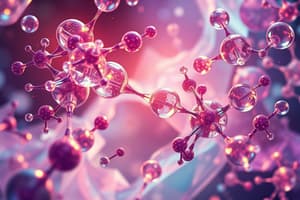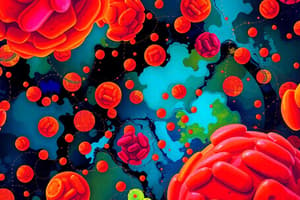Podcast
Questions and Answers
What is the name of the disease that is responsible for the most worldwide deaths historically?
What is the name of the disease that is responsible for the most worldwide deaths historically?
Malaria
Which of the following diseases has an essentially 100% case fatality rate?
Which of the following diseases has an essentially 100% case fatality rate?
- H5N1 avian influenza
- Ebola haemorrhagic fever
- Rabies (correct)
- Marburg haemorrhagic fever
How many species are there estimated to be in the genus Cinchona?
How many species are there estimated to be in the genus Cinchona?
38
The bark of the Cinchona tree is not medicinally active.
The bark of the Cinchona tree is not medicinally active.
Which year did Louis Pasteur produce quinotoxine by acid-catalyzed isomerization of quinine?
Which year did Louis Pasteur produce quinotoxine by acid-catalyzed isomerization of quinine?
Who established the correct atom connectivity for quinine in 1907?
Who established the correct atom connectivity for quinine in 1907?
What year did Rabe and Kindler synthesize quinine from quinotoxine?
What year did Rabe and Kindler synthesize quinine from quinotoxine?
Who published a stereoselective quinine synthesis in 2001?
Who published a stereoselective quinine synthesis in 2001?
What is the other name for paracetamol?
What is the other name for paracetamol?
What is the name of the lab that released Tylenol Children's Elixir in 1955?
What is the name of the lab that released Tylenol Children's Elixir in 1955?
What chemical is used to reduce 4-nitrophenol to 4-aminophenol in the paracetamol total synthesis?
What chemical is used to reduce 4-nitrophenol to 4-aminophenol in the paracetamol total synthesis?
What is the name of the toxic metabolite that is associated with paracetamol metabolism?
What is the name of the toxic metabolite that is associated with paracetamol metabolism?
NAPQI is always produced in large amounts during paracetalmol metabolism.
NAPQI is always produced in large amounts during paracetalmol metabolism.
Name two local anaesthetics used for pain relief, that act in a similar manner to AM404.
Name two local anaesthetics used for pain relief, that act in a similar manner to AM404.
What is the name of the endogenous cannabinoid that AM404 may inhibit uptake by neurons?
What is the name of the endogenous cannabinoid that AM404 may inhibit uptake by neurons?
Which of the following is NOT a name used for paracetamol?
Which of the following is NOT a name used for paracetamol?
Flashcards
Rabies
Rabies
An infectious disease caused by a virus transmitted through the saliva of infected animals, primarily bats and dogs. The virus attacks the nervous system, leading to inflammation of the brain. It is nearly always fatal once symptoms develop.
Ebola haemorrhagic fever
Ebola haemorrhagic fever
A highly contagious and severe hemorrhagic fever caused by the Ebola virus. It is characterized by fever, muscle pain, vomiting, and internal bleeding. The fatality rate is around 83% and there is currently no cure.
Marburg haemorrhagic fever
Marburg haemorrhagic fever
A highly contagious and severe hemorrhagic fever caused by the Marburg virus. Symptoms are similar to Ebola, including fever, muscle pain, vomiting, and bleeding. The fatality rate is around 80%, with no cure available.
H5N1 avian influenza
H5N1 avian influenza
Signup and view all the flashcards
Nipah virus
Nipah virus
Signup and view all the flashcards
Tuberculosis (TB)
Tuberculosis (TB)
Signup and view all the flashcards
Malaria
Malaria
Signup and view all the flashcards
Quinine
Quinine
Signup and view all the flashcards
Total synthesis of quinine
Total synthesis of quinine
Signup and view all the flashcards
Isomerization
Isomerization
Signup and view all the flashcards
Catalyst
Catalyst
Signup and view all the flashcards
Antibiotic
Antibiotic
Signup and view all the flashcards
Antimalarial
Antimalarial
Signup and view all the flashcards
Chloroquine
Chloroquine
Signup and view all the flashcards
Amodiaquine
Amodiaquine
Signup and view all the flashcards
Paracetamol
Paracetamol
Signup and view all the flashcards
IUPAC name
IUPAC name
Signup and view all the flashcards
International Nonproprietary Name (INN)
International Nonproprietary Name (INN)
Signup and view all the flashcards
British Approved Name (BAN)
British Approved Name (BAN)
Signup and view all the flashcards
United States Adopted Name (USAN)
United States Adopted Name (USAN)
Signup and view all the flashcards
Proprietary name
Proprietary name
Signup and view all the flashcards
Acetanilide
Acetanilide
Signup and view all the flashcards
Methemoglobinemia
Methemoglobinemia
Signup and view all the flashcards
Cyclooxygenase (COX) enzymes
Cyclooxygenase (COX) enzymes
Signup and view all the flashcards
AM404
AM404
Signup and view all the flashcards
Anandamide
Anandamide
Signup and view all the flashcards
Drug metabolism
Drug metabolism
Signup and view all the flashcards
Cytochrome P450 enzymes
Cytochrome P450 enzymes
Signup and view all the flashcards
N-acetyl-p-benzo-quinone imine (NAPQI)
N-acetyl-p-benzo-quinone imine (NAPQI)
Signup and view all the flashcards
Glutathione detoxification
Glutathione detoxification
Signup and view all the flashcards
Acetylcysteine
Acetylcysteine
Signup and view all the flashcards
Study Notes
Medicinal Chemistry Introduction
- This is an introductory course in medicinal chemistry, CH456.
- The course was created by James H. Gerlach in 2025.
The Five Deadliest Infectious Diseases
- Rabies has an essentially 100% case fatality rate.
- Ebola hemorrhagic fever has an 83% case fatality rate.
- Marburg hemorrhagic fever has an 80% case fatality rate.
- H5N1 avian influenza has a ~60% case fatality rate.
- Nipah virus has a 40% to 70% case fatality rate.
Share of Total Disease Burden by Cause, World 2021
- This data measures the total burden of disease, including years of life lost and years lived with disability.
- One DALY (Disability-Adjusted Life Year) equals one lost year of healthy life.
- Cardiovascular diseases and respiratory infections and tuberculosis are among the leading causes.
- The data is categorized by cause (e.g., cancers, respiratory infections, etc.)
Share of Total Disease Burden by Cause, Canada 2021
- Similar to the global data, this data measures the disease burden in Canada.
- Leading causes include cancers, cardiovascular diseases, and musculoskeletal diseases.
- The data is divided into communicable, maternal, neonatal, nutritional diseases, and injuries.
Disease Burden From Communicable, Maternal, Neonatal and Nutritional Diseases, World
- This chart displays the estimated disease burden from communicable, maternal, neonatal, and nutritional diseases.
- Burden is measured in DALYs (Disability-Adjusted Life Years) per year.
- It shows a downward trend in disease burden over time for these disease categories around the world.
Disease Burden From Communicable, Maternal, Neonatal and Nutritional Diseases, Canada
- Similar to the global data, this chart displays the estimated disease burden from communicable, maternal, neonatal, and nutritional diseases in Canada.
- The data reveals a fluctuating pattern over time in Canada.
Deaths from Infectious Diseases, 1980 to 2021
- The chart tracks the estimated number of deaths annually due to various infectious diseases worldwide.
- There is a clear declining death rate pattern for the world.
- The chart also displays a similar downward trend.
Global Trends in the Estimated Number of TB deaths and Mortality Rate for 2000-2020
- This chart illustrates the global trend in TB deaths over a 20-year period (2000-2020).
- It shows the estimated number of TB deaths per year (log scale) and the mortality rate per 100,000 population per year (log scale).
The Deadliest and Most Communicable Diseases
- This chart categorizes diseases by fatality and communicability.
- It visualizes diseases like Rabies, Ebola, and various types of influenza.
Malaria is the Disease Responsible Historically for the Most Worldwide Deaths
- Malaria is deadly and preventable.
- It is transmitted by infected female Anopheles mosquitoes and it is a major worldwide concern.
- In 2023, there were an estimated 263 million cases and 597,000 deaths. Cases and deaths have been reported in Africa.
Countries with Indigenous Cases of Malaria in 2000 and Their Status by 2023
- A world map displays the status of malaria cases.
True Size of Africa
- Africa's size in relation to other countries is displayed for understanding.
Quinine
- Cinchona bark, from South American trees, contains quinine.
- Quinine treats malaria, and quinidine treats heart conditions.
- The Countess of Chinchón was the first European reportedly cured from malaria using Peruvian bark.
Homeopathy and Cinchona
- Dr. Samuel Hahnemann, the founder of homeopathy, studied cinchona bark effects.
- Hahnemann's alleged hypersensitivity to cinchona bark is a historical aspect of homeopathy.
Discovery of the Malaria Parasite
- Alphonse Laveran, a French military doctor, discovered a motile parasite causing malaria after a posting to Algeria in 1878.
- He was awarded the Nobel Prize in 1907.
Quinine
- Quinine is a white crystalline alkaloid.
- It's antimalarial, analgesic, antipyretic, anti-inflammatory, and has a bitter taste.
Quinine Total Synthesis Milestones
- Efforts spanning over 150 years led to quinine total synthesis.
- Major figures include Pelletier, Caventou, Pasteur, Perkin, Rabe, Kindler, Woodward, Doering, Stork, Kondo, and Mori among others.
- There were various difficulties, and debates regarding validity of the synthesis methods and results.
Woodward-Doering Quinine Synthesis
- The Woodward-Doering method for quinine synthesis is a historical and crucial milestone in organic chemistry.
- The pathway and details of the synthesis are illustrated in the image.
Quinine Total Synthesis
- Rabe and Kindler synthesized quinine from quinidine in 1918.
- Their method was a crucial step toward quinine total synthesis.
- There were debates and challenges about the validity of early syntheses.
Related Antimalarial Drugs
- Chloroquine (1934) and Amodiaquine (1948) are related antimalarial drugs.
- Their chemical structures are shown in the slides.
Paracetamol (Acetaminophen)
- Paracetamol (Acetaminophen) is a widely used analgesic.
- Its chemical structure and IUPAC name are mentioned.
Paracetamol Total Synthesis.
- There are steps involved in the generation of Paracetamol.
- Fractional distillation is one of the key steps in generating the paracetamol.
Paracetamol Mechanism of Action
- Paracetamol acts through cyclooxygenase (COX) enzyme pathways.
- It also acts by metabolizing in the body to AM404 which inhibits uptake of anandamide.
Paracetamol Metabolism
- Paracetamol is mainly metabolized in the liver to sulfate and glucuronide conjugates.
- Toxic metabolites also form due to CYP metabolic pathways.
- Glutathione helps detoxify these toxic metabolites.
Reactions Involved in Paracetamol Metabolism
- The various reactions involved in metabolizing Paracetamol are shown.
- The pathway also shows the toxic metabolic reaction.
NAPQI Toxicity
- NAPQI (N-acetyl-p-benzoquinone imine) is a toxic metabolite of paracetamol.
- It causes covalent binding to cellular proteins, causing DNA damage.
Treating Paracetamol Overdoses
- Treatment for paracetamol overdose involves acetylcysteine to replenish glutathione levels.
- Early intervention is crucial for success in paracetamol overdose cases.
Studying That Suits You
Use AI to generate personalized quizzes and flashcards to suit your learning preferences.
Related Documents
Description
This quiz introduces the foundational concepts of medicinal chemistry as outlined in course CH456 by James H. Gerlach, created in 2025. Explore key principles and significant aspects of the field that influences drug development and therapeutic applications.




